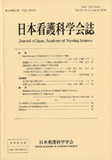Japanese
English
- 販売していません
- Abstract 文献概要
- 参考文献 Reference
要旨
本研究の目的は,Joint Attentionの発達的変化,Joint Attentionと後の子どもの発達との関係を明らかにすることである.35組の母子を対象に,13・18・24か月時の遊び場面を縦断的に観察・録画し,Joint Attentionの出現率を算出した.Joint Attentionは,Coordinated Joint AttentionとPassive Joint Attentionに分類した.また,子どもの発達指標には,新版K式発達検査を用いた.分析の結果,1)Joint Attentionの出現率は,Coordinated Joint Attentionでは月齢による差はみられず,Passive Joint Attentionでは,月齢と共に有意に増加した.このJoint Attention出現率の推移は,米国母子を対象とした先行研究と量的,質的に差異がみられ,この差異に影響を及ぼす因子を明らかにする必要性が示唆された.2)13,18か月時のJoint Attention出現率と,24か月時のK式発達検査による発達指数との間に正相関がみられ,Joint Attention出現率が後の子どもの発達を予測する可能性が示唆された.本研究で得られた結果は,子どもの発達を支援する看護職にとり,発達査定や介入効果測定を行う上での基礎資料として位置づけられ,有効に活用されることが望まれた.
Abstract
The purpose of this study was to elucidate the developmental changes in joint attention and the effects of joint attention on child development. The subjects were 35 mothers and their infants. Mother-Infants' play sessions were observed and recorded on videotape in their homes when the infants were 13, 18 and 24 months old. Joint attention was categorized into coordinated joint attention (CJA) and passive joint attention (PJA). The Kyoto Scale of Psychological Development (KSPD) was used to assess child development. The main findings were as follows.
1) There were no differences in CJA according to the age of the child, but PJA increased significantly with the age of the child.
2) Joint attention when the child was 13 and 18 months old was positively correlated with KSPD when the child was 24 months old.
The results of this study on joint attention using Japanese mothers and infants as subjects differed both qualitatively and quantitatively from those obtained from studies performed in USA. The results of this study suggest that subsequent child development can be predicted by the degree of joint attention during infancy.
Copyright © 2000, Japan Academy of Nursing Science. All rights reserved.


